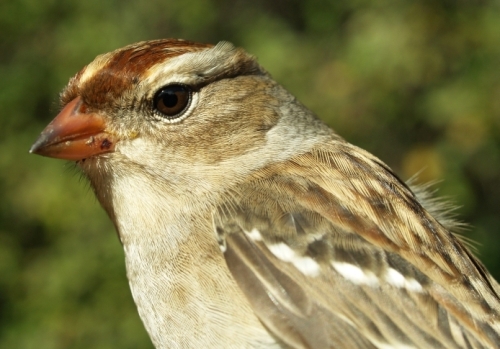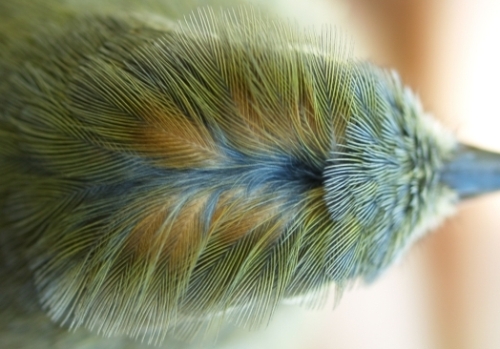|
Week 9: September 26 - October 2, 2009 |
Welcome
to the McGill Bird Observatory weekly report.
Click here for a complete listing of our archives.
Comments or
questions are welcome at "mbo AT migrationresearch.org".
|
PICTURE
OF THE WEEK: |
|

We are now solidly into sparrow season at MBO. While White-throated and Song
Sparrows were (yet again) by far the most common species, White-crowned Sparrows
are also becoming more numerous, with this hatch-year bird being one of 13
that we banded over the course of this week.
(Photo by Simon Duval)

|
MBO
gratefully acknowledges the financial support
provided for the 2009 Fall Migration Monitoring
Program by TD Friends of the Environment Foundation
|
|
|
|
THIS WEEK |
THIS FALL |
2009 TOTAL |
SITE TOTAL |
|
# birds (and species) banded |
371 (43) |
1832 (69) |
2836 (82) |
21757 (105) |
|
# birds (and species) repeat |
93 (13) |
379 (33) |
658 (44) |
4005 (66) |
|
# birds (and species) return |
2 (1) |
32 (16) |
150 (32) |
604 (37) |
|
# species observed |
78 |
127 |
161 |
198 |
|
# net hours |
459.0 |
4568.0 |
7926.5 |
38391.8 |
|
# birds banded / 100 net hours |
80.8 |
40.1 |
35.7 |
56.7 |
|
|
Note: table does not include nocturnal banding (owls) |
|
Banders-in-charge: Simon Duval, Gay Gruner
Assistants: Sheldon Andrews, Veronica Aponte, Christine Barrie, Jean Beaudreault, Jean Demers,Catherine Doucet, Shawn Craik, Nicki and Mike Fleming, Tiffany Gilchrist, Marie-Anne Hudson, Meg Langley, Barbara MacDuff, Dan Mardena, Meghna Marjadi, Alison Moore, Chris Murphy, Alex Stone, Clémence Soulard, Alexis Thorbecke, Rodger Titman, Carine Touma, Matthew Von Bornhoft
Notes: We're pleased to report that for a second week in a row we can say we've had our busiest week of the fall to date - though on the other hand, it's also true again that numbers pale in comparison to this time last year. In fact, while the 371 birds banded this week are nearly a 50% increase over last week's count, the total is but a small fraction of the 1113 during the same time in 2008. Of course, last year we were experiencing the unprecedented invasion of Yellow-rumped Warblers at this time, while this year they only managed to make it into fourth place for the week. In previous years the total for week 9 ranged from 311 to 545, so we're well within that range.
Having banded and observed a good diversity of species already this season, we actually ended up not adding any new species to either list this week. However, we had some species as repeats for the first time this fall (Ruby-crowned Kinglet, White-crowned Sparrow, and Purple Finch) or even for the year (Blue-headed Vireo and Gray-cheeked Thrush). We had some other interesting observations this week, including a few Northern Goshawk sightings, and a strong migration on Wednesday night that resulted in a nice fallout on Thursday morning with nearly 100 birds banded despite a morning shortened by rain. Among those we had at least half a dozen Blue-headed Vireos, contributing to our high total for the week of 21 - more than we've had in most full fall seasons! That day Ruby-crowned Kinglet and Yellow-rumped Warblers abounded, especially near the E nets, while the shrubs bordering the path between D and E were shivering with sparrows. More and more flocks of mixed blackbirds are being observed and a gang of screaming Blue Jays have been making themselves noticeable as they patrol the area.
The larger than usual numbers of Blue Jays migrating through MBO over the past few weeks and the Goshawk sightings this week are consistent with elements of the 2009-2010 "Winter Finch forecast" issued recently by Ron Pittaway of the Ontario Field Ornithologists. Based on an expected decline of snowshoe hare and Ruffed Grouse in northern Ontario, the fall flight of Northern Goshawks should be above average this year and/or next year, while the nut crops (acorn, beech, hazelnut) in Ontario were for the most part poor, forcing the Blue Jays to move south. While conditions might be somewhat different in Quebec, chances are there are similarities, and our observations support that. As for the finches ... the review of cone and seed crops across Canada suggests that it may be a relatively quiet winter for finch-watching at MBO, but we hope to monitor the site throughout winter all the same and perhaps find at least a few species hanging around our feeders. But before we get to that, we still have a few final weeks of fall migration to enjoy.

Orange-crowned Warblers are often relatively drab green and can be rather inconspicuous, but when in the hand, there's an opportunity to inspect the crown more closely, sometimes revealing the orange feathers.
(Photos by Simon Duval)

|
Just like last week, White-throated and Song Sparrows account for the top two species banded this week, with the White-throats commandingly in the lead. Ruby-crowned Kinglets, which have in all previous years been in second place during week 9, were finally picking up in numbers and landed in third place. Blue-headed Vireos in fourth place were unexpectedly abundant, while at the other extreme Yellow-rumped Warblers were tied for fourth place, but were surprisingly scarce. But it seems like they are exhibiting a substantial two-year cycle in numbers ... in odd-numbered years we have had relatively few Yellow-rumped Warblers during this week (21, 12, and 21), while in even years we've had at least ten times more (236 and 688). Obviously the population itself can't be changing that much from year to year, so to some degree the variability must be a function of the birds following different migratory strategies. Needless to say, we're very curious to see whether we are in for a big influx again next fall. Lower down the list, Nashville and Magnolia Warblers are still being banded in decent numbers, and yet again the Black-throated Blue Warblers were numerous enough to squeak into the list. Hermit Thrushes rounded out this week's top ten.
This week’s top 10 [last week's rank in brackets]
# individuals banded |
mean # individuals observed daily |
1. White-throated Sparrow (100) [1] |
1. Canada Goose (757.7) [1] |
2. Song Sparrow (50) [2] |
2. Common Grackle (79.9) [4] |
3. Ruby-crowned Kinglet (45) [-] |
3. American Robin (68.4) [6] |
4. Blue-headed Vireo (21) [-] |
4. White-throated Sparrow (68.3) [5] |
4. Yellow-rumped Warbler (21) [-] |
5. American Crow (47.0) [2] |
6. White-crowned Sparrow (14) [-] |
6. European Starling (34.7) [-] |
7. Nashville Warbler (13) [5] |
7. Blue Jay (26.7) [7] |
8. Magnolia Warbler (11) [3] |
8. Song Sparrow (25.9) [-] |
9. Black-throated Blue Warbler (8) [5]
9. Hermit Thrush (8) [-] |
8. Cedar Waxwing (23.9) [3] |
10. Black-capped Chickadee (20.7) [10] |
|
Nearly by a factor of ten, Canada Goose remained the most numerous species observed this week. Common Grackle, American Robin, and White-throated Sparrow have all been on the increase, while American Crows and Cedar Waxwings were noticeably less common this week. European Starling and Song Sparrow vaulted on to the top ten list this week, while American Goldfinch and Red-winged Blackbirds were pushed off. Black-capped Chickadees and Blue Jays held their positions, both probably on the strength of migrants moving through, augmenting the number of local residents.
|

Wait a minute - what's this? We expect that we're on the verge of welcoming our annual October onslaught of American Robins - but if we ever spot a European Robin like this among them we'll be quite astonished. This fine fellow graces this week's report by virtue of MBO Coordinator Marcel Gahbauer attending a conference in Scotland this week but suffering withdrawal and dreaming about MBO at night ... and at one point integrating European Robins into that storyline! Plus, it's just too cute not to share!
(Photo by Marcel Gahbauer)

After a year off from the project, our Saw-whet banding program is back on track, with the young female above our first capture of the season, on Thursday night.
(Photo by Gay Gruner)

To our surprise, the Indigo Buntings just keep on coming, again banded almost daily this week. It seems like every one of the after-hatch-year birds has a somewhat different pattern of colouration.
(Photo by Simon Duval)
|







